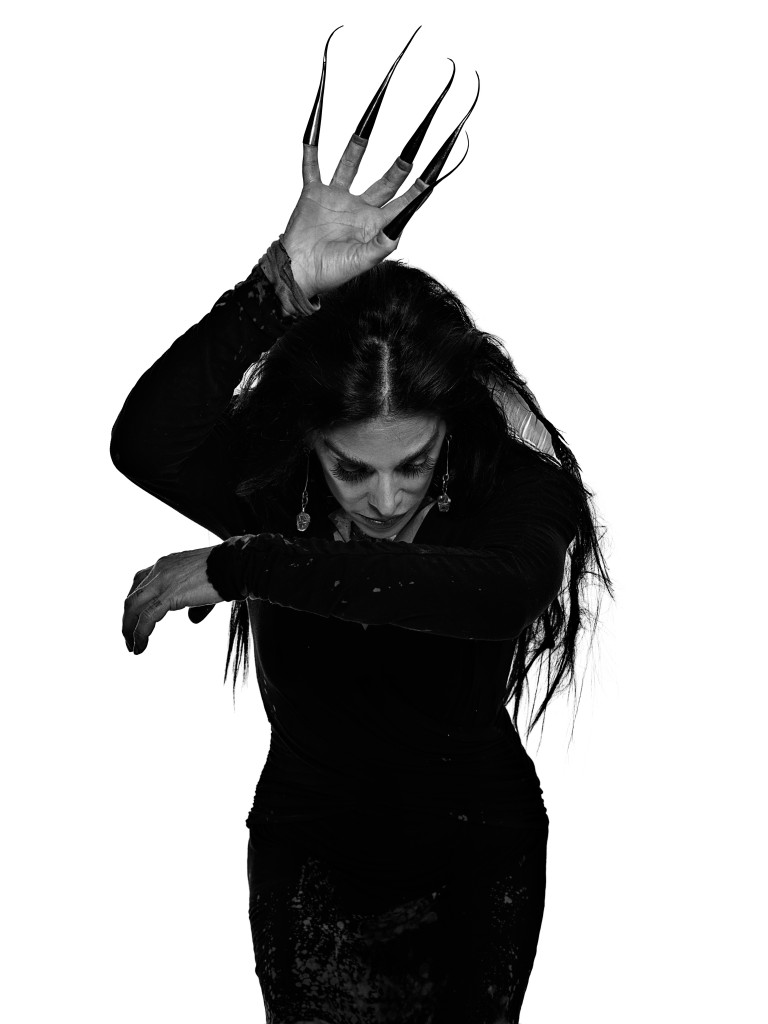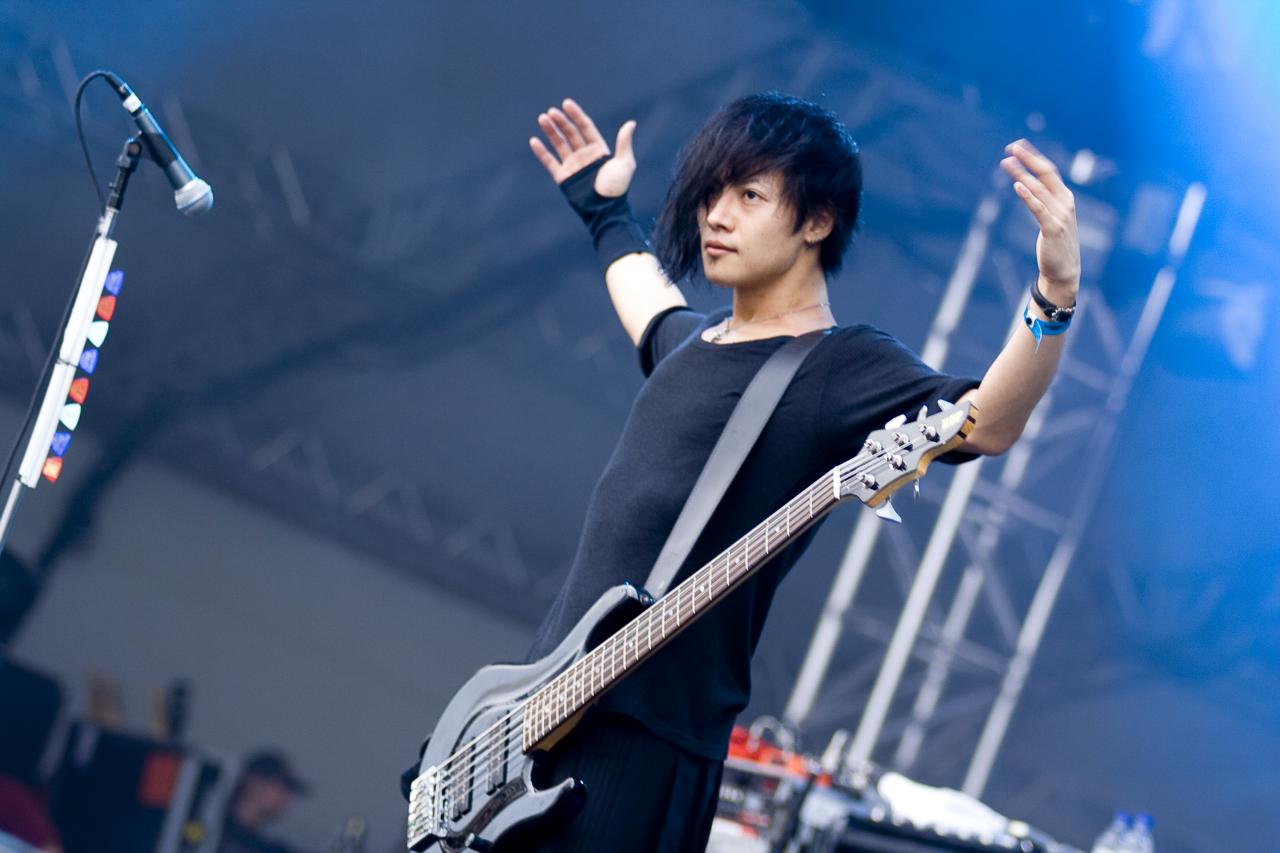by Shane Lange:
Women in Horror Month may be over but its examination of gender roles and issues is an ongoing process. One must look askance at prevailing values in order to see them from different perspectives and avant-garde composer, vocalist, musician and artist Diamanda Galas has made the interrogation of Western culture a key component of her art for over 30 years. Equal parts challenging visionary music and terrifying catharsis, her work has addressed social issues that affect marginalized groups, including prisoners and victims of war, AIDS sufferers, and the mentally ill. Most recently she has also added visual art to her list of projects as she paints in a dark, erratic tribal style, similar to horror author Clive Barker’s illustrative work (see gallery, below). Though juggling a very busy schedule, Galas took some time to answer a few questions via email for DarkMedia (note: except where indicated, bold quotes are taken from Galas’ own writings).
“He was a transgressive artist who truly challenged the comfort level of his audience. In days that closely followed the era of ‘All You Need Is Love’ he was asking how you explain all of the horror and destruction in the world.”
This seems an apropos description of your work as well – as a sort of indictment of humanity. In some of your writing you’ve mentioned the vampire as a metaphor for the artist – but given that the vampire is a mythical creature from folklore and fiction – how do you feel about horror in the arts – does it mock real suffering?
DG: I will approach this diagonally.
The idea of the werewolf, for example, which comes from the Greek word Vrykola — meaning the undead — described a person who was improperly buried, therefore not really interred in the earth. And so the Vrykola went out at night looking for justice, looking for the people who executed him and/or did not really bury him.

Photo by Allan Amato
I don’t separate mythology from “real” life. Something that is a myth has not been proven to either exist or not exist, as far as Western Civilization is concerned. It is something that has a history that is almost timeless. And this brings us back to the werewolf, the Vrykola, of Greek mythology. Before Greek burial, there was a ritual of taping up the mouth, the anus — all of the orifices — in order to make sure that none of the poison got out of the body, in a sense, but also to make sure that the deceased person could not suck a villager into his own flesh. If this was not practiced, it meant that the funeral was not graceful. There’s a very big deal around these funeral rituals, which are not practiced by all Greeks, but by many, especially in the villages.
Again, a myth is something that cannot be proved or disproved by Western society. But the persons in village culture believe it. The Russians have similar myths — they are brought up in school to believe in the Vrykola: It’s a serious study there.
Let me just say that the Greeks have nothing to do with Western culture. Western culture may have been influenced by them, but Anatolia, for example, means, “sun setting in the East.”
“he music or the words of kindred souls can sooth the pain of maniacs or the depressed.”
Is it the purpose of the darkest art, then: to heal one’s spirit?
DG: No. The purpose of the darkest art, as concerns me, is that it acts as an exorcism of that which is troubling me deeply. It paints it. It doesn’t spell it out, but rather, somehow, the vocabulary I have allows me to paint an analogue of the experience, the misery, and therefore get rid of it for the time being. But only because of that vocabulary, because if the vocabulary is not good enough, then I may not paint something that is honest, and this would make the pain I experience present constantly.
When I’m doing other work, I’m not thinking about anyone but myself, and after, if it soothes other people, then that’s a nice thing to hear, but it’s a separate reality completely. If I were in this business to soothe other people, I would become a therapist; that would be a much more direct way to deal with it. Then I might have people do their own versions of this activity. But I do feel, honestly, since having been to mental hospitals, and having performed for people in them, that if you have a precise knowledge of your craft, and your emotions are able to be transparent through this craft, that people experiencing a similar type of emotion will get it.
But this may be naïve thinking that I will question probably to the day that I die.
There are many works that I do that come out of a horror of what I see or know about tortured human beings — those incarcerated by politicians, the old in nursing homes or maltreated in their own homes, those left in basements in handcuffs and legcuffs. When I have seen or heard about these things from friends in Africa, in Greece, in America, I am possessed by it, it becomes part of my body, and I must create something to have a dialogue with these people, even if they do not hear it. This is different, of course — with the exception of the media it generates in favor of the persecuted — from direct activism, which I must be part of as well. But that is not art; that is a completely different, extroverted activity which is also necessary to me.
“A great performer is a vampire. We have trained to be thus.”
“The vampire knows that only new blood will sustain her. New blood, new research, new language study, and willful deconstruction and reconstruction, new meter, new arrangements, new writing, difficult performances–which later become great ones– through perseverance.”
If the artist-vampire lives to unbalance, disrupt, and prey upon preexisting structures and concepts, then is one responsible for sustaining what one creates? Is the artist-vampire accountable for what is created?
DG: When I used the word vampire in this context, I was using it as Baudelaire used it — being a vampire at my own veins. That means that my blood must be fresh. It must be changing all the time, otherwise I would get sick on it. This has no relationship to my description of the vampire who preys upon other people. It’s the same action but it’s aimed in a completely different direction. Unfortunately with this sometimes miserable job of being an artist, you really can’t escape yourself; at least I cannot escape myself unless I create new work…. if I don’t have something new to draw on in myself then I experience the excoriation of all depressives…
“The radio bans silence. We are accompanied by a soundtrack of pop music when we go to the store, wherever we go … They hit you with a brick in the head so that you end up with a tin can for a brain.” Diamanda Galás
If this is how dissent is controlled – by drowning it in cacophony, and sensory overload – how does an artist find an audience now?
DG: It’s a very good question. The way we find an audience is curious. What appears to be a clever manipulation of the population by businessmen who play their artists’ pop music in drug stores, restaurants, toilets and shopping malls, may result in a dead response to it… Perhaps then a person will be heard to say to his friend, “Wouldn’t it be nice to go to a concert and hear some real music?” And the answer to that will be: “Please…”
The result might be two different types of entertainment available to the consumer. The first he can get in the toilet while he’s taking a crap, and the second he can only get by going to serious performance venues, rather than, for example, awards shows.
I’ve been hearing a lot of comments to the effect of, “Is it really necessary to have a Women in Horror Month, do women need to be recognized as a group?” and, while I can understand that it may be a frustrating subject for people – no one has any definitive answers; it’s a complex subject, etc. – I think they are forgetting how important it is to continue asking these questions. Many of them are too young to understand the necessity, and that concerns me. The question, then, is: for those young men and women who are too young to have witnessed women’s earlier struggles to challenge patriarchy, can they afford not to continue asking these questions?
DG: Well, I have only to think of Ida Lupino, who wrote and directed REAL horror, and the answer is YES, because, unfortunately, without this token gesture towards women, they will, in general, be thought of as the playboy bunny whose role in the, let’s suppose, rabid insect film, caterpillared her way into a series of creature films.
I think there is no harm in separating the boys from the women; after all, why should a potential matriarchy want to be men? They are separate creatures and deserve their own pedestals. Yes, it is hard being a woman in all professions. If you are disinterested in going to bars and drinking with the boys, you have lost already 80 percent of your potential allies. Unless you are the one throwing the party, like Ida, who ruled the roost.
When you attain a certain stature, you can do that and then you can be the dominatrix with El Presidente in one hand and a cigarillo in the other, and call the shots.
Please visit Diamanda Galas on her website and official Facebook page.
When he’s not writing for DarkMedia, Shane Lange swims in the cultural sea, up to his ears in music, film, and literature. If it’s dark, and it’s smart, chances are you’ve got his attention.
















33 Comments